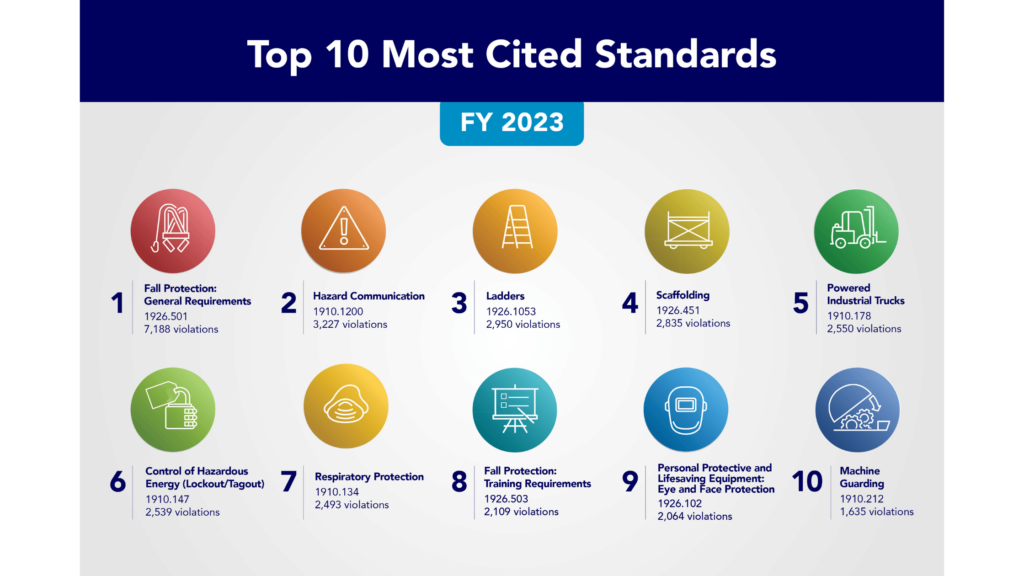The Occupational Safety and Health Administration (OSHA) plays a key role in keeping workers safe by setting and enforcing safety standards on the job. Machine guarding, scaffolding, and respiratory protection are among the top 10 most common OSHA citations in construction. Understanding OSHA’s top citations can help you avoid hefty fines and, more importantly, keep your workers safe.
In construction, following these regulations isn’t just about avoiding legal trouble—it’s essential for creating a safe and efficient workplace. Ignoring OSHA standards can lead to serious consequences, like heavy fines or, worse, injuries and fatalities.
Here are the most common OSHA citations and how to avoid them.
10 most common OSHA citations

10. Machine guarding
Standard number: 1910.212
Number of violations: 1,635
Machine guarding violations occur when machinery parts like rotating components, nip points, or sparks are not adequately shielded to prevent worker injury. This remains a persistent issue across various industries, particularly manufacturing. Improper or missing guards can expose workers to severe risks such as amputations, burns, or crushing injuries. Employers must ensure that all machines are properly guarded and regularly inspected to avoid these costly violations and safeguard employees.
9. PPE and lifesaving equipment
Standard number: 1926.102
Number of violations: 2,064
Personal protective equipment (PPE) violations are common when employers fail to provide or maintain adequate gear like face shields, goggles, or hard hats. These violations expose workers to serious hazards such as chemical burns, falling debris, or inhalation risks. Roofing contractors are frequently cited for failing to equip their workers properly. Ensuring all employees are outfitted with the correct PPE is essential to reducing risks on the job.
8. Fall protection training
Standard number: 1926.503
Number of violations: 2,109
This violation arises when employees are not provided with adequate training on fall protection systems, putting them at risk of serious injury or death from falls. Proper training is critical for employees who work at heights, yet many companies fail to provide it. Ensuring all employees are trained and retrained as necessary can drastically reduce the risk of falls, one of the leading causes of workplace fatalities.
7. Respiratory protection
Standard number: 1910.134
Number of violations: 2,493
Respiratory protection violations happen when employees are not provided with adequate respirators or training for environments with airborne hazards such as dust, fumes, or gases. Failing to conduct fit tests or provide medical evaluations can lead to long-term health consequences for workers, particularly in industries like automotive and construction.
6. Lockout/tagout
Standard number: 1910.147
Number of violations: 2,539
Lockout/tagout violations occur when companies fail to implement or enforce proper procedures for controlling hazardous energy during machine maintenance. Without these safeguards, workers can be injured by machinery’s unexpected startup, which can cause serious injuries. Following the required protocols and performing regular inspections of energy control procedures is crucial.
5. Powered industrial trucks
Standard number: 1910.178
Number of violations: 2,550
The Powered Industrial Trucks standard focuses on safely using equipment like forklifts. Violations occur due to improper operator training, unsafe handling, and neglecting equipment maintenance. Ensuring proper training, regular inspections, and adherence to safety protocols can prevent accidents.
4. Scaffolding
Standard number: 1926.451
Number of violations: 2,835
Scaffolding violations are common and often involve improper setup or lack of fall protection measures. Workers using scaffolds are at high risk of falling if guardrails and other safety measures are not in place. Following OSHA’s scaffolding safety standards can help prevent these avoidable accidents.
3. Ladders
Standard number: 1926.1053
Number of violations: 2,950
Ladders are one of the most frequently misused tools on construction sites. Violations of this standard often involve using defective ladders, overloading them, or failing to secure them properly. These issues frequently result in falls, making ladder safety a critical focus for any work at heights.
2. Hazard communication
Standard number: 1910.1200
Number of violations: 3,227
This standard refers to the control of hazardous energy during machine maintenance and servicing. Violations occur when proper lockout/tagout procedures are not followed, leading to the risk of machinery unexpectedly starting and causing serious injuries. Proper training, regular inspections, and enforcing procedures can significantly reduce these risks.
1. Fall protection, general requirements
Standard number: 1926.501
Number of violations: 7,188
Consistently, the most cited OSHA violation is fall protection violations, which involve the failure to provide adequate protection for workers working at heights. This includes not installing guardrails or safety nets or using harnesses. Falls remain one of the leading causes of workplace fatalities, particularly in construction. Addressing these violations can save lives and reduce injuries.
Bottom line
Staying compliant with OSHA standards isn’t just about avoiding fines—it’s about keeping your team safe and healthy. Many of these violations, like fall protection and machine guarding, are entirely preventable with a little extra care and proactive planning. By regularly training your employees, conducting safety inspections, and sticking to established procedures, you can prevent accidents before they happen.



3 comments